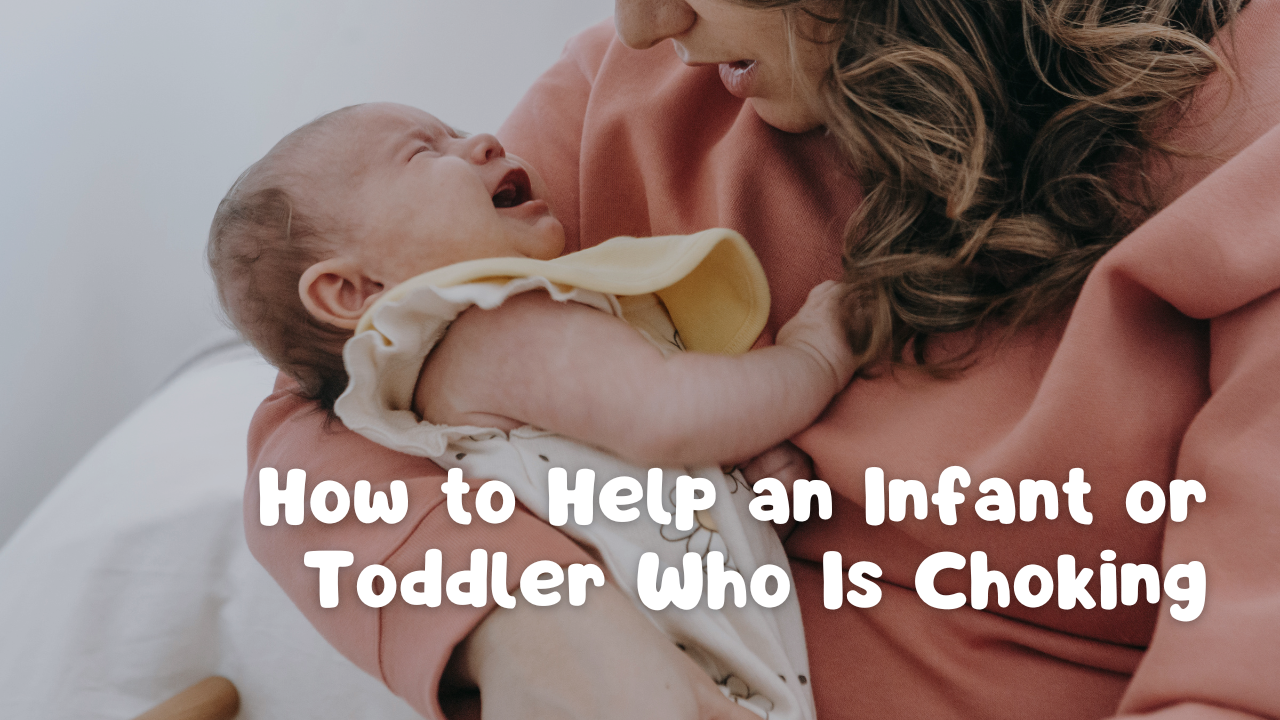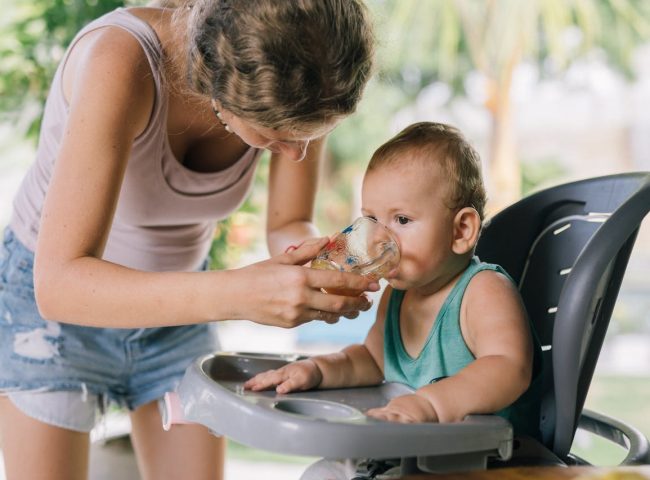How to Help an Infant or Toddler Who Is Choking? Choking is one of the leading causes of injury and death among young children, especially those under 4 years old. Choking occurs when a foreign object, such as food, toy, or button battery, blocks the airway and prevents breathing.
Choking can lead to brain damage or death if not treated quickly and effectively. As a parent or caregiver, you need to know how to prevent, recognize, and treat choking in infants and toddlers. You also need to know how to perform first aid and CPR in case of a choking emergency. This complete and detailed guide will provide you with the information and skills you need to help your child in case of choking.
How to Prevent and Help an Infant or Toddler Who Is Choking?
The best way to prevent choking is to keep small objects out of your child’s reach and supervise them closely when they are eating or playing and help an Infant or Toddler Who Is Choking. Here are some tips on how to prevent choking in infants and toddlers:
- Cut food into small pieces that are easy to chew and swallow. Avoid giving hard, round, sticky, or slippery foods that can easily get stuck in the throat, such as whole grapes, nuts, popcorn, candy, hot dogs, marshmallows, or gum.
- Encourage your child to sit upright and eat slowly. Do not let them eat while lying down, walking, running, or playing. Do not distract them with toys or screens while they are eating.
- Keep small objects such as coins, marbles, beads, buttons, batteries, magnets, jewelry, or pen caps away from your child. Store them in locked cabinets or containers that are out of reach. Check toys for loose or broken parts that can pose a choking hazard.
- Teach your child not to put anything in their mouth that is not food or a pacifier. Do not let them chew on pencils, crayons, balloons, or plastic bags. Do not give them toys that are too small for their age or have small parts that can detach.
- Learn how to perform first aid and CPR for infants and toddlers. Take a certified course from a reputable organization such as the American Red Cross or the American Heart Association. Keep a first aid kit and a list of emergency numbers handy at home and in your car.
How to Recognize and Help an Infant or Toddler Who Is Choking?
Choking can happen quickly and silently, so you need to be alert for signs of choking in your child. Some signs of choking are:
- Difficulty breathing, coughing, gagging, wheezing, or making high-pitched noises
- Turning blue or pale in the face, lips, or fingernails
- Clutching the throat or pointing to the mouth
- Drooling or spitting out saliva
- Losing consciousness or becoming limp
If your child is choking but can still breathe, cough, or make sounds, let them try to cough up the object on their own. Monitor them closely but do not interfere forcefully unless their condition worsens.
How to Treat Choking in Infants and Toddlers
If your child is choking and cannot breathe, cough, or make sounds, they need immediate help. Call 911 and follow the steps below to dislodge the object.
How to Treat and help an Infant or Toddler Who Is Choking (Under 1 Year Old)
If your infant (under 1 year old) is choking, use back slaps and chest thrusts, not the Heimlich maneuver. Here are the steps to follow:
- Hold the infant facedown on your forearm, with their head lower than their trunk, and support their head and jaw with your hand.
- Deliver up to five firm back blows with the heel of your other hand between the shoulder blades.
- Check the infant’s mouth and remove any visible obstructions with your fingertips. Do not put your fingers into the mouth unless you can see and grasp the object easily.
- If the back blows do not work, turn the infant faceup on your forearm or thigh, still with their head lower than their trunk, and place two fingers in the center of their chest just below the nipple line.
- Give up to five quick, upward chest thrusts, compressing the chest by about one-third.
- Continue alternating back blows and chest thrusts until the object is dislodged, emergency help arrives, or the infant becomes unconscious.
- If the infant becomes unconscious, lay them on a firm, flat surface and start CPR. Tell 911 immediately.
How to Treat and help an Infant or Toddler Who Is Choking (Over 1 Year Old)
If your toddler (over 1 year old) is choking, use abdominal thrusts (also known as the Heimlich maneuver). Here are the steps to follow:
- Stand or kneel behind your child and wrap your arms around their waist.
- Make a fist with one hand and place it just above their navel. Grab your fist with your other hand and pull sharply inward and upward.
- Repeat up to five abdominal thrusts until the object is dislodged, emergency help arrives, or the child becomes unconscious.
- If the abdominal thrusts do not work, give back blows as described for infants. Alternate between abdominal thrusts and back blows until the object is dislodged or the child becomes unconscious.
- If the child becomes unconscious, lay them on a firm, flat surface and start CPR. Tell 911 immediately.
How to Perform CPR on an Infant or Toddler Who Is Choking
CPR stands for cardiopulmonary resuscitation. It is a lifesaving technique that involves chest compressions and rescue breaths to restore blood flow and oxygen to the brain and other vital organs.
If an infant or toddler who is choking becomes unconscious or stops breathing, you need to perform CPR until emergency help arrives. Here are the steps to follow:
How to Perform CPR on an Infant (Under 1 Year Old)
- Lay the infant on their back on a firm, flat surface. Tilt their head back slightly by lifting their chin with one hand and pushing down on their forehead with the other hand. This will open their airway.
- Look inside their mouth and remove any visible obstructions with your fingertips. Do not put your fingers into their mouth unless you can see and grasp the object easily.
- Give two rescue breaths by covering their mouth and nose with your mouth and blowing gently for one second each. Watch for their chest to rise and fall. If it does not rise, reposition their head and try again. If it still does not rise, continue with chest compressions.
- Place two fingers in the center of their chest just below the nipple line. Press down hard and fast about 30 times at a rate of 100 to 120 compressions per minute. Each compression should be about one-third of the depth of their chest.
- After 30 compressions, give two more rescue breaths as described above. Continue alternating 30 compressions and two breaths until emergency help arrives or the infant starts breathing normally.
How to Perform CPR on a Toddler (Over 1 Year Old)
- Lay the toddler on their back on a firm, flat surface. Tilt their head back slightly by lifting their chin with one hand and pushing down on their forehead with the other hand. This will open their airway.
- Look inside their mouth and remove any visible obstructions with your fingertips. Do not put your fingers into their mouth unless you can see and grasp the object easily.
- Give two rescue breaths by pinching their nose shut and covering their mouth with yours. Blow gently for one second each and watch for their chest to rise and fall. If it does not rise, reposition their head and try again. If it still does not rise, continue with chest compressions.
- Place the heel of one hand in the center of their chest between the nipples. Place your other hand on top of the first hand and interlock your fingers. Press down hard and fast about 30 times at a rate of 100 to 120 compressions per minute. Each compression should be about one-third of the depth of their chest.
- After 30 compressions, give two more rescue breaths as described above. Continue alternating 30 compressions and two breaths until emergency help arrives or the toddler starts breathing normally.
How to Prevent Choking Complications in Infants and Toddlers
Even if you successfully dislodge the object from your child’s airway, you should still take them to see a doctor as soon as possible. This is because choking can cause complications such as:
- Infection or inflammation of the lungs (pneumonia) or airways (bronchitis)
- Damage to the vocal cords or larynx
- Swelling or bruising of the throat or neck
- Aspiration of foreign material into the lungs
- Brain damage due to lack of oxygen
A doctor can examine your child and check for any signs of these complications. They can also provide treatment if needed, such as antibiotics, steroids, oxygen therapy, or surgery.
To prevent choking complications in infants and toddlers, you should also:
- Keep a close eye on your child for any signs of breathing difficulty, fever, coughing, wheezing, or vomiting after a choking episode
- Encourage your child to drink plenty of fluids to keep their throat moist and prevent dehydration
- Avoid giving your child any foods or drinks that may irritate their throat or cause further choking, such as spicy, acidic, or carbonated foods or drinks
- Seek medical attention immediately if your child shows any signs of choking complications or if you are concerned about their condition
How to Help an Infant or Toddler Who Is Choking
Choking is a scary and stressful situation for both you and your child. However, by following the steps above, you can help your child breathe again and prevent serious harm.
Here is a summary of how to help an infant or toddler who is choking:
- If your child is choking but can still breathe, cough, or make sounds, let them try to cough up the object on their own
- If your child is choking and cannot breathe, cough, or make sounds, call 911 and perform back blows and chest thrusts for infants or abdominal thrusts for toddlers
- If your child becomes unconscious or stops breathing, call 911 and perform CPR until emergency help arrives
- If you successfully dislodge the object from your child’s airway, take them to see a doctor as soon as possible
- Watch out for any signs of choking complications and seek medical attention if needed
Remember that choking can be prevented by keeping small objects out of your child’s reach and supervising them closely when they are eating or playing. You should also learn how to perform first aid and CPR for infants and toddlers by taking a certified course from a reputable organization.
By knowing how to prevent, recognize, and treat choking in infants and toddlers, you can save your child’s life and avoid serious consequences.
FAQs About Choking in Infants and Toddlers
Here are some frequently asked questions about choking in infants and toddlers:
Q: What are some common causes of choking in infants and toddlers?
A: Some common causes of choking in infants and toddlers are:
- Food items such as whole grapes, nuts, popcorn, candy, hot dogs, marshmallows, gum, or chunks of meat or cheese
- Non-food items such as coins, marbles,beads, buttons, batteries, magnets, jewelry, or pen caps
- Household items such as plastic bags, balloons, coins, safety pins, or marbles
- Toys or parts of toys that are too small for their age or have small parts that can detach
- Medications or vitamins that are not stored safely or given inappropriately
Q: What are some foods that are safe for infants and toddlers to eat?
A: Some foods that are safe for infants and toddlers to eat are:
- Soft, cooked fruits and vegetables that are cut into small pieces or mashed
- Soft, cooked meats, poultry, fish, or tofu that are cut into small pieces or shredded
- Cooked eggs, cheese, yogurt, or cottage cheese
- Cooked cereals, pasta, rice, or bread that are moistened with milk, water, or sauce
- Smooth nut and seed butters that are spread thinly on bread or crackers
- Soft snacks such as banana slices, avocado chunks, cooked beans, or cheese cubes
Q: How can I teach my child to eat safely?
A: You can teach your child to eat safely by:
- Modeling good eating habits such as sitting upright, chewing well, and swallowing before talking
- Encouraging your child to eat slowly and calmly and not to stuff their mouth with food
- Praising your child for eating well and following the rules
- Avoiding scolding or distracting your child while they are eating
- Providing your child with appropriate utensils and cups for their age and skill level
Q: How can I make my home safer for my child?
A: You can make your home safer for your child by:
- Keeping small objects out of your child’s reach and sight
- Storing medications, vitamins, cleaning products, and other hazardous substances in locked cabinets or containers
- Checking toys regularly for loose or broken parts and discarding any damaged ones
- Installing safety gates, locks, guards, and covers on stairs, doors, windows, outlets, and appliances
- Supervising your child closely when they are eating or playing
Q: What should I do if I witness someone else’s child choking?
A: If you witness someone else’s child choking, you should:
- Ask the parent or caregiver if they need help and if you can perform first aid on their child
- If they agree, follow the steps above to treat choking in infants or toddlers
- If they refuse or are not present, call 911 and perform first aid until emergency help arrives
- If the child becomes unconscious or stops breathing, perform CPR as described above
Q: How can I learn more about choking prevention and first aid?
A: You can learn more about choking prevention and first aid by:
- Taking a certified course on first aid and CPR for infants and toddlers from a reputable organization such as the American Red Cross or the American Heart Association
- Reading reliable sources of information such as the CDC website or the Mayo Clinic website
- Talking to your child’s doctor or nurse about any questions or concerns you may have
Conclusion
Choking is a serious and potentially life-threatening emergency that can affect infants and toddlers. By following the tips above, you can prevent choking in your child and help them breathe again if they choke. You can also learn how to perform first aid and CPR for infants and toddlers by taking a certified course from a reputable organization. By knowing how to prevent, recognize, and treat choking in infants and toddlers, you can save your child’s life and avoid serious consequences.
We hope this article has been helpful and informative for you. If you have any feedback or questions, please feel free to contact us. Thank you for reading and stay safe!
⚠️ Remember, these steps are not a substitute for professional medical advice. Always contact emergency services immediately when dealing with a choking incident.







